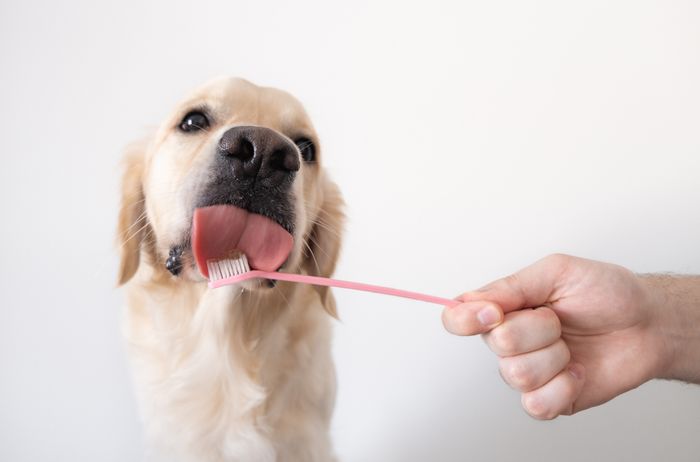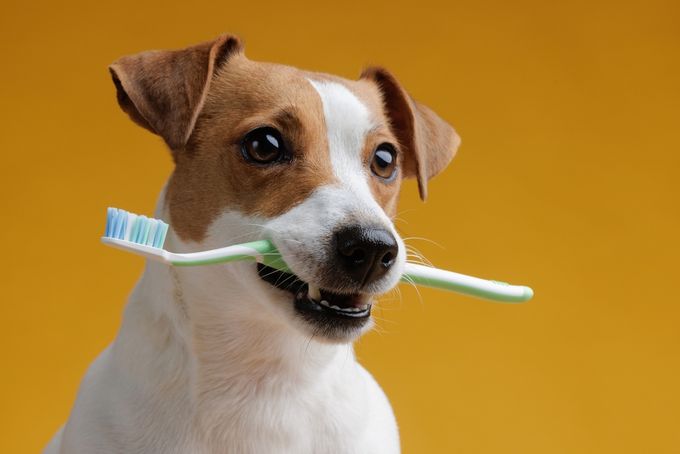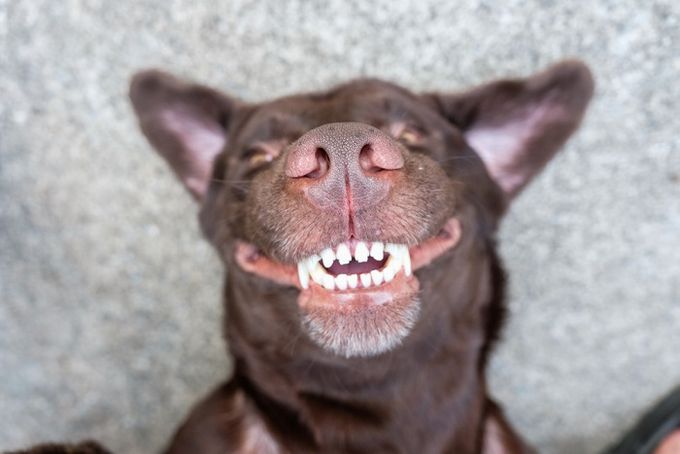9 Most Common Reasons for and Symptoms of Bad Teeth in Dogs
Find out when the right time is to seek veterinary care for your dog's dental issues and what to expect during those visits.
Published February 5, 2024.
Our expert team independently researches and recommends the best pet insurance providers. We publish reviews that are unbiased and not influenced by payments we receive from advertising partners.

Regular dental care is critical for dogs, though often overlooked. Poor dental hygiene can lead to disease, decay, pain, and tooth loss, allowing bacteria into the bloodstream. An unhealthy mouth decreases comfort and well-being. As caregivers, we must monitor for concerning signs through brushing, chews, and professional cleanings. Prioritizing oral health adds quality years by preventing major issues down the line.
The Importance of Good Dental Health
Many people think their dog's bad breath is endearing or normal. Today's big takeaway is that unpleasant doggy breath is not normal; it's a sign of a problem in the mouth--something for owners to pay attention to.
The importance of good dental health goes beyond the mouth. One of the main things we want to avoid is chronic dental and periodontal disease pain. This disease is related to bacteria, plaque, and tartar buildup on the teeth and below the gum line, which, owners may not realize, is the most dangerous part.
We're not just trying to prevent local mouth pain; the bigger danger is systemic issues throughout the body if bacteria enter the bloodstream. Studies show that 80 to 90% of dogs over three, without dental care, already have dental and periodontal disease. It's more common in small-breed dogs, but some large-breed dogs like Greyhounds can have this issue.
9 Common Symptoms of Bad Teeth in Dogs
Being an observant dog owner can aid you in making good dental health decisions for your canine. Here's a list of nine of the most common reasons and symptoms of bad dental issues seen in dogs:
1. Gingivitis
Gingivitis, characterized by inflamed gums, is a common dental issue in dogs. Similar to humans, dogs can experience bleeding or sensitivity when their gums are inflamed. Recognizing this early stage is crucial for proactive dental care.
2. Plaque and Tartar Buildup
The accumulation of plaque, a sticky film of bacteria, and its hardening into tartar on a dog's teeth, known as calculus, is another concern. This process can lead to various dental problems, emphasizing the importance of regular dental care routines.
3. Periodontal Disease or Periodontitis
This condition indicates a more severe form of dental disease extending below the gum line, often resulting from prolonged plaque buildup and gingivitis. The formation of a biofilm by mouth bacteria on the teeth and under the gum line contributes to the progression of periodontal disease. Contrary to popular belief, dogs' mouths need diligent cleaning to prevent this cycle of plaque development.
4. Loose or Missing Teeth
Some are easier to see than others, and it happens secondary to periodontal disease. Bacteria build-up degrades the periodontal ligament and the bone holding the tooth into the jaw.
Realize that teeth falling out without extraction isn't a badge of honor. It indicates significant bone destruction. Dogs may swallow the fallen teeth, but the severity of the issue may not be apparent.
5. Retained Baby Teeth (Deciduous Teeth)
Retained baby teeth are common in small breeds with two rows of teeth. Anesthetizing and removing them prevents damage to permanent teeth, overcrowding, jaw issues, and tartar buildup. Though not always an emergency, it's best to address extra teeth, especially long canine teeth.
If baby teeth haven't fallen out by 6 months when adult teeth erupt, they likely won't come out on their own. This is often a genetic issue seen more in certain breeds:
- Toy and small breeds - Pomeranians, Maltese, Shih Tzus, Pekingese
- Brachycephalic breeds - Bulldogs, French Bulldogs, Pugs
- Miniature and teacup breeds - Miniature Schnauzers, Teacup Poodles and Yorkies
6. Fractured Teeth
This commonly happens when dogs chew on various items, including toys, bones, and objects they find. I advise pet owners that chew toys should have some flexibility to prevent tooth fractures.
Items like hard Nyla bones, antlers, horse and pig hooves, and any bone that lacks flex can lead to tooth breakage. Surprisingly, even ice cubes, despite being seemingly harmless, can result in broken teeth.
7. Tooth Root Abscess
A fractured tooth can lead to a tooth root abscess if untreated. Breakage leaves pulp exposed for bacteria to infect the long tooth root. Multi-rooted tooth extractions are especially challenging.
Bacteria spreads into the fractured tooth's root canal. Treatment options then include a specialized root canal or difficult tooth extraction.
8. Gingival Hyperplasia
This can result from a dog's genetics, often seen in breeds like Boxers. It causes bumpy growths on the gums and can be related to chronic inflammation in the mouth. Laser treatment may be used to remove excessive tissue to prevent tartar trapping.
9. Oral Tumors or Cancer
Although generally not preventable, any growth in the mouth should be checked by a vet immediately. The importance of regular oral examinations and swift action in the case of suspicious growths cannot be overstated. Early detection is critical for appropriate treatment and management.
🐾 Take care of your pup's health by providing proper dental hygiene
Causes and Signs of Dental Problems in Dogs
Being a proactive dog owner involves recognizing and addressing common symptoms of bad teeth in dogs.
- Smelly breath: The first one is bad breath; foul doggy breath is not normal. Puppy breath is different and somewhat sweet, but once they have their adult teeth, their mouth should have a neutral smell. Offensive breath indicates a problem.
- Red or swollen gums: If your dog allows you to lift the lip and pull it way back, you can inspect the teeth at the back, where plaque and tartar may accumulate. Look for inflammation, redness, swelling, or bleeding.
- Tartar buildup: If you see brownish-yellow gook or hard material on the teeth that you can pick with your finger, it's a sign of developing plaque, likely below the gum line.
- Difficulty eating: If your dog is dropping food or having difficulty chewing hard food, check for any obvious issues. Open the mouth to see if there's something lodged or if there's an obvious loose or discolored tooth. Owners can look for signs at home depending on how well the dog allows examination.
- Excessive drooling: While drooling doesn't necessarily indicate dental disease and could be a sign of nausea, dogs in pain may drool more. If you notice excessive drooling, especially in breeds not prone to it, investigate what might be happening.
- Signs of blood: Normal dog teething or losing teeth may result in a bit of blood, like on their toys. However, investigate further if you suddenly see blood where you normally wouldn't or if it's not a teething puppy.
- Pain: Detecting pain in dogs is difficult as they often mask it. Signs include rubbing their face with a paw or against surfaces, which could also indicate itchiness. Examining your dog's overall behavior can help diagnose the main problem.
- Lethargy or lacking response: Sudden lethargy, less playfulness, or irritability may signal dental issues in dogs, as discomfort or pain can cause behavioral changes. Addressing oral disease can revitalize a dog's activity levels and behavior.
Preventative Measures
Dental health relies on caring dog owners and veterinarians working together. Discuss recommended products with your vet, as not all chew toys support oral health equally. Ideally, brush your dog's teeth daily with enzymatic toothpaste. Use finger brushes or infant toothbrushes for puppies, making it part of training. Check for signs of oral disease like red gums, loose teeth, or bad breath, and get prompt veterinary exams.
If daily brushing is unrealistic, consider oral rinses applied directly to teeth and gums. Some products help prevent bacteria buildup and coat teeth. Second-tier options are dental treats and chews, focusing on enzyme-treated, malleable products that may protect teeth. Prescription dental diets with large kibble for chewing are also available. The Veterinary Oral Health Council provides recommendations.
A strong point of prevention is being prepared for anything, and investing in a comprehensive pet insurance plan, like those offered by Wagmo Pet Insurance, will give you peace of mind that your hound's dental care is taken care of.
When to Seek Veterinary Care
Routine vet care is important for discussing any concerns, even if you think there's no issue. An annual visit covers nose-to-tail. Good practice is addressing growths, red flags, or abnormalities promptly with your vet. Sedated exams allow for a full examination and treatment discussion.
Non-anesthetic cleanings can cause stress and miss hidden issues. Correctly administered anesthesia is safe, enabling vets to identify and address more dental problems. Prioritizing vet collaboration ensures a happier, healthier dog life, even if it means tooth extraction. Addressing problems now prevents bigger issues down the line.
🐾 Be covered for veterinary care with these 5 best pet insurance providers for dogs
Available Treatment Options
Routine dental care involves a simple dental prophy (cleaning) for dogs with staining or tartar. This is performed under anesthesia for effectiveness, safety, and reduced stress. The frequency varies, with larger breeds often needing it less frequently. The specific treatment plan depends on findings during the sedated exam.
Costs can vary, and vets might estimate broadly due to the uncertainties of awake exams. Procedures might include breaking it into stages, considering full mouth extractions for severe cases, or even root canals and crowns for specific situations. Though less common, there are options like braces for dogs with alignment issues, but these are case-specific.
Prevent Bad Teeth in Your Dog
A healthy mouth is not just about a sparkling smile; it's the key to a longer, happier life for your beloved pet. Regular dental check-ups, proper hygiene routines, and a nutritious diet contribute to preventing various dental issues.
Considering the unexpected nature of health concerns, investing in your dog's future well-being becomes paramount. Wagmo Pet Insurance offers peace of mind, ensuring your canine companion receives the best possible care without the burden of unexpected financial strains. Safeguard your dog's health, and let their vibrant, toothy grin shine through a lifetime of joy and vitality.



